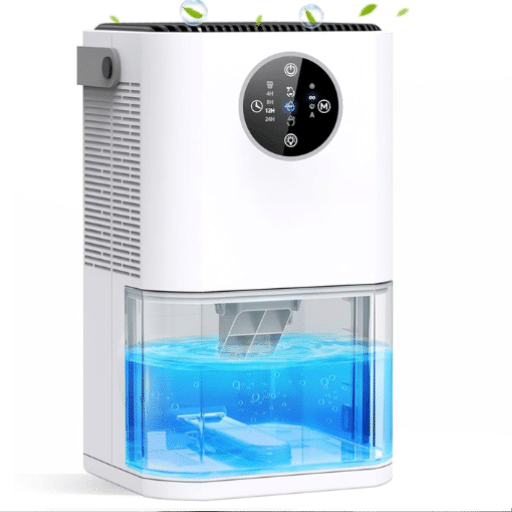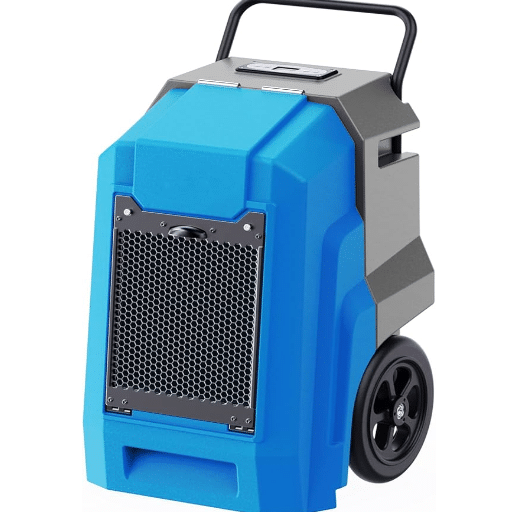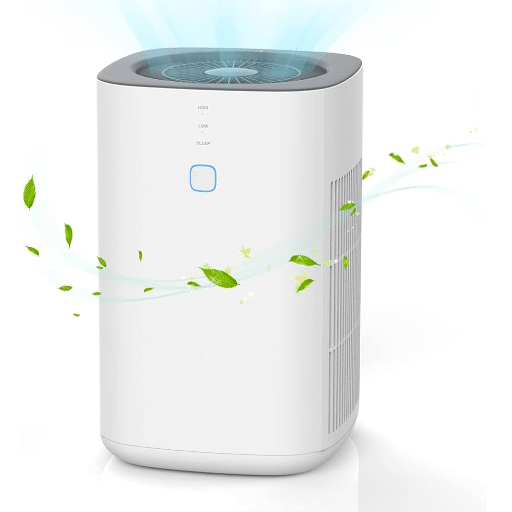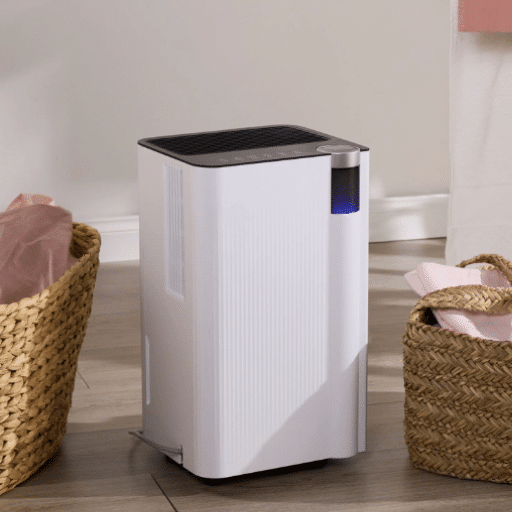Moisture control in a tiny bedroom or study might be a headache. Moisture in a confined room communicates discomfort, bad smells, and the kind of conditions where mold can flourish. Thus comes the small dehumidifier—small yet mighty in keeping even the smallest room dry, fresh, and comfortable.
This article takes you through the finest small dehumidifiers specially sorted for small spaces, boasting their attributes and benefits that can actually turn your bedroom into a place for healthy and pleasurable living. Whether it is seasonal humidity or dampness that is straight at full roaring measure all the way through, this guide would help you look for your perfect calm island.
Benefits of Using a Dehumidifier in a Small Bedroom

Better Air Quality
A dehumidifier extracts excess moisture from the air, thereby avoiding the formations of mold, mildew, and dust mites—that are common allergens that actually degrade air quality. By countering these problems, a dehumidifier offers good air quality, especially where air circulation is limited in small bedrooms. This prevents any sort of respiratory irritation and eases symptoms for people that are allergic or have asthma.
Removal of Discomfort Related to Humidity
High humidity makes for uncomfortable nights as sticky and heavy air weigh down one’s comfort. Dehumidifying keeps the air clean and comfortable; therefore, the dehumidifier assists in creating sound sleep. With humidity levels around 30-50 percent, you may welcome a cozy and relaxing ambience for that quality rest.
Preservation of Furniture and Personal Belongings
Dampness spells doom for furniture, walls, and other belongings, with conditions like mold, wood warping, or paint peeling endowed under it. Dehumidifiers work to counter that and protect bedroom possessions and extend the life of these assets.
Energy-Efficient Complement to AC Units
Joining your air conditioning system with a dehumidifier makes its life easier. Cooler dry air means less energy consumption and lower prices, which fits your small bedroom budget!
Key Benefits Summary
- Improved Air Quality: Reduces mold, mildew, and dust mites
- Enhanced Comfort: Maintains optimal humidity levels (30-50%)
- Property Protection: Prevents damage to furniture and belongings
- Energy Savings: Works efficiently with air conditioning systems
How to Choose the Best Small Dehumidifier

Some key considerations when buying the best small dehumidifier are essential to accommodate your needs:
Understanding Pint Capacity
Pint capacity refers to the amount of moisture that a dehumidifier can extract from the air over a 24-hour period, measured in pints. Depending upon size and humidity level, a proper pint capacity is selected:
- Small rooms with moderate humidity: 20-30 pint capacity
- Larger or wetter areas: 50+ pints for effectiveness
- Tiny bedrooms/bathrooms: 10-20 pints usually sufficient
Energy Efficiency: Energy Star Rated Options
Energy Star dehumidifiers are designed with energy efficiency in mind; they use less electricity without compromising on greater performance. These dehumidifiers:
- Comply with strict regulations in conservation of energy
- Result in lower utility bills and less environmental impact
- Provide long-term savings and align with green lifestyle choices
Size and Portability Considerations
When selecting a dehumidifier, choosing the right size and portability features leads to convenience and efficiency:
- Small dehumidifiers: Fit in confined spaces like bathrooms or closets
- Lightweight models: Easy to transport from room to room
- Mobility features: Look for wheels and carrying handles
Top-Rated Small Dehumidifiers for Bedrooms

Pro Breeze Electric Mini Dehumidifier
- Capacity: 9 oz per day
- Coverage: Up to 150 sq. ft.
- Noise Level: Ultra-silent operation
- Best For: Small bedrooms and quiet spaces
- Price Range: $60-$70
Tenergy Sorbi 1000ml Air Dehumidifier with Air Purifying Function
- Special Feature: HEPA filter for air purification
- Capacity: 1000ml tank
- Design: Compact and portable
- Best For: Dual function – dehumidifying and air purifying
Eva-Dry EDV-1100 Electric Petite Dehumidifier
- Capacity: 16 oz per day
- Technology: Thermoelectric (whisper-quiet)
- Best For: Tight spaces like closets and small bedrooms
- Price Range: $40-$50
Comparison of Features and Performance
| Model | Moisture Removal | Coverage Area | Noise Level | Energy Efficiency | Portability |
|---|---|---|---|---|---|
| Pro Breeze Electric Mini | 9 oz/day | Up to 150 sq. ft. | Whisper-quiet | Low consumption | Lightweight |
| hOmeLabs 1,500 Sq. Ft | 22 pints/day | Up to 1,500 sq. ft. | Low noise | Energy Star rated | Wheels included |
| Eva-Dry EDV-1100 | 16 oz/day | Small spaces | Thermoelectric quiet | Ultra-efficient | Compact design |
Energy Efficiency Tips for Dehumidifiers

Optimal Placement and Settings
- Central Location: Place dehumidifier centrally in the room with free air flow
- Avoid Obstructions: Keep away from walls and furniture that block airflow
- Proper Height: Position on a table or stand for better air circulation
- Humidity Control: Maintain ideal indoor levels (30-50%)
Maintenance for Maximum Efficiency
- Clean Filters: Replace or clean filters according to manufacturer recommendations
- Right Size: Choose appropriate capacity for your room size
- Timer Functions: Use built-in timers to prevent excessive operation
- Smart Features: Utilize humidity sensors and automatic controls
💡 Pro Tip: Optimal Settings for Small Rooms
For small bedrooms, set your dehumidifier to maintain 30-50% relative humidity. This range prevents mold growth while ensuring comfort and protecting furniture and electronics.
References
-
The Role of Humidifiers and Dehumidifiers in Your HVAC Setup – Explains the role of dehumidifiers in managing indoor air quality.
-
Controlling Moisture Problems in Your Home – A resource from the University of Minnesota Extension on using dehumidifiers to manage indoor humidity.
-
Dehumidifiers – ENERGY STAR’s official page on portable room dehumidifiers, including their benefits and usage.
Frequently Asked Questions (FAQ)
What dehumidifier suits a small bedroom best?
Generally, the best dehumidifier for a small bedroom will be one that combines efficiency with portability. Look for small models, such as mini or 30-50 pint capacity dehumidifiers. Energy Star models can save on energy costs and do an efficient job removing moisture from the air.
How does a portable dehumidifier operate?
A portable dehumidifier passes air in through a fan, carrying the air over cold coils where moisture is condensed, and then exhausted out into the room as dry air. The moisture is collected in a water tank, or can be drained by a drain hose for constant operation. A portable type dehumidifier is perfect for small spaces like bedrooms or bathrooms.
In bathrooms, can dehumidifiers be used?
Yes, and bathroom dehumidifiers can help to maintain controlled humidity levels and prevent mold from forming. A small unit will work efficiently to deflate moisture, particularly in areas that lack ventilation. Search for a portable small dehumidifier for bathroom use that can be transported and operated with ease.
What humidity level should a bedroom have?
Typically, the ideal humidity level for bedrooms ranges from 30 to 50 percent. Maintaining it within this range allows for comfort, prevents mold growth, and protects furniture and other belongings. Dehumidifiers in the bedroom can ensure that this humidity level is maintained.
How often do we empty water tanks in dehumidifiers?
The emptying frequency depends on the moisture content in your surrounding and the size of the tank of the dehumidifier. Small dehumidifiers might have to be emptied every day, while larger units with a water tank of 50 pints or more will last a couple of days before they have to be emptied.
Are Energy Star dehumidifiers a worthy investment?
Yes, an Energy Star dehumidifier is a worthy investment, given that the rating means higher efficiency and lower electricity bills. These highly efficient dehumidifiers are designed to extract moisture from the air while consuming as little energy as possible. Thus, they present a sustainable option for home use.
What size dehumidifier should I get for a smaller room?
For a small room, like a bedroom or bathroom, a dehumidifier with a capacity of 30 up to 50 pints will usually suffice. Keep in mind the size of the room in square feet when buying so you can get the best performance possible.
Is it possible to use a dehumidifier in the basement?
Absolutely, in fact, it is highly recommended to use a dehumidifier in the basement, especially in moisture-prone regions. A commercial dehumidifier or a model of larger capacity would manage to control the humidity level while preventing mold from spreading and thus enhancing air quality throughout the house.
What is a quiet dehumidifier?
A quiet dehumidifier operates with minimum noise, making it suitable for use in bedrooms, or any other calm zones in the home. Look out for models advertised as ultra-quiet or featuring a sleep mode timer, so your dehumidifier may remain inconspicuous while maximizing moisture removal.



